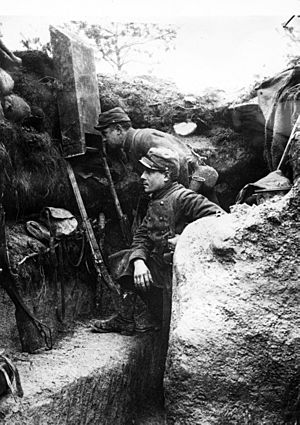Attrition warfare facts for kids

A war of attrition is a military strategy where one side tries to win by causing huge losses to the enemy. They aim to destroy so many soldiers and so much military equipment that the enemy gets worn down and eventually gives up. The side with more resources, like soldiers and weapons, usually wins this type of war.
Contents
What is a War of Attrition?
In a war of attrition, both sides keep fighting, hoping the other side will run out of people or supplies first. It's like a long, tough race where the goal is to exhaust your opponent. This strategy often leads to very long and costly wars.
Why Attrition is Risky
Military experts, like the ancient Chinese general Sun Tzu, often say that attrition is not the best way to win a war. Sun Tzu famously said, "The supreme art of war is to subdue the enemy without fighting." This means it's better to win smartly, without losing many of your own soldiers or resources.
In a war of attrition, both sides might think they can win. But often, both sides end up losing a lot more than they expected. They might even end up with fewer resources than when they started. For example, during the Vietnam War, the United States used "search and destroy" missions, which were a form of attrition. However, this didn't work because the enemy was willing to keep fighting, even with heavy losses. This shows that attrition wars don't always work if your enemy is determined to continue the fight.
The American Civil War Example
During the American Civil War, Union Army General Ulysses S. Grant started using a war of attrition strategy. This began with the Battle of the Wilderness in 1864. Instead of trying to capture the Confederate capital, Grant focused on directly attacking Lee's Army of Northern Virginia.
The Battle of the Wilderness was the first major fight in the Union army's Overland Campaign. Neither side won a clear victory, and both suffered many losses. About 28,000 soldiers were killed or wounded in total. Grant knew that even though his army had more losses in this battle, any losses for the Confederacy would hurt them more. This was because the North had many more soldiers and supplies available. So, Grant believed that the sacrifices made by the Union army were worth it to weaken the Confederacy.
World War I: A Clear Example
One of the clearest examples of a war of attrition is World War I, especially on the Italian and Western Fronts. Both sides fought for years, constantly trying to wear each other down. They kept fighting until one side simply ran out of men, horses, food, and other military supplies needed to continue the war. This led to huge numbers of casualties and a very long, difficult conflict.
Images for kids
See also
 In Spanish: Guerra de desgaste para niños
In Spanish: Guerra de desgaste para niños


